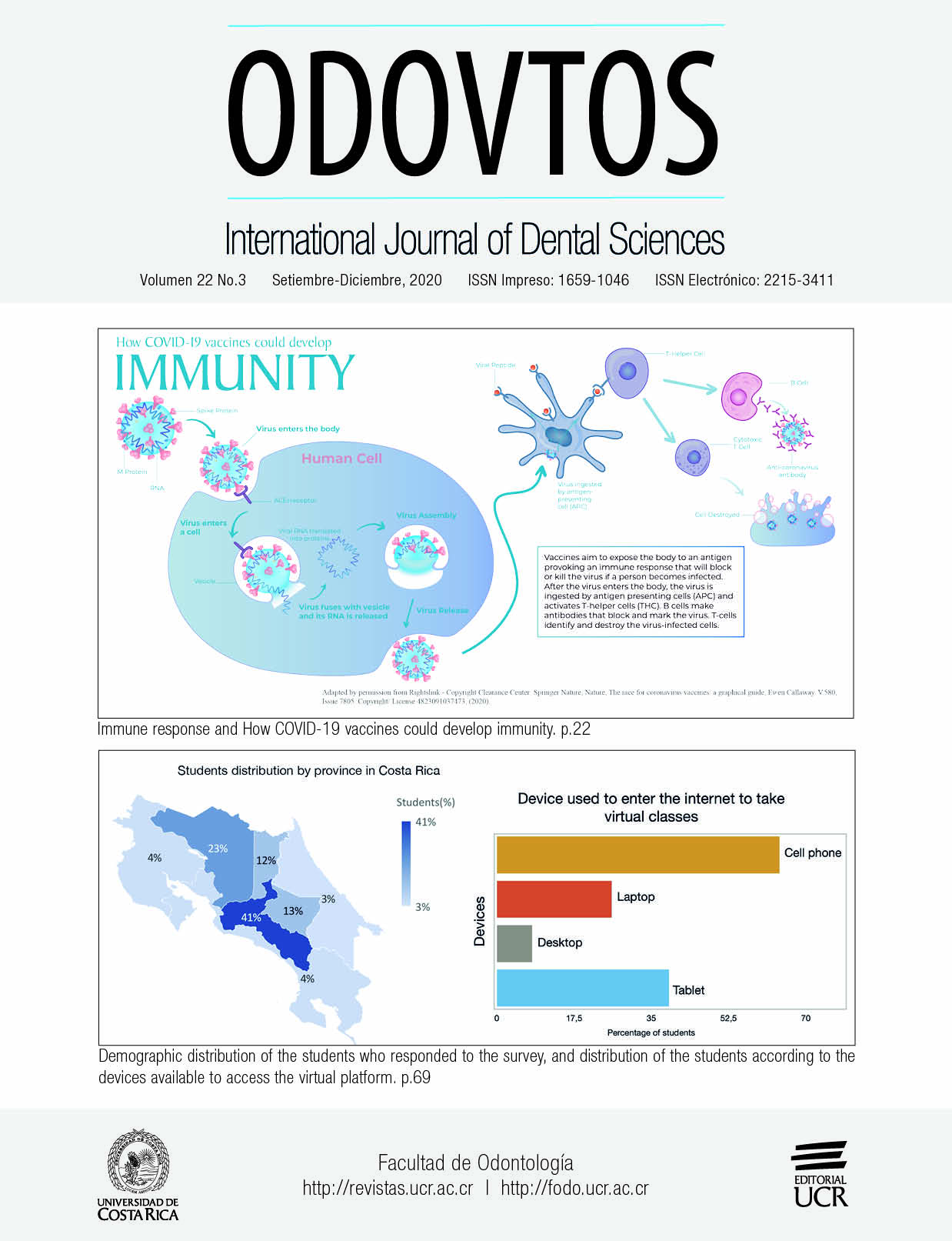Abstract
ECA2 receptors have an important gene expression in the squamous cells of the tongue and salivary glands, a mechanism that is convenient for the inoculation of SARS CoV2 since it seeks to make the assembly complex through its glycoprotein or spike protein towards the ECA2 receptor of the oral mucosa. Once inoculated and favored by proteases, it is the key that allows the entry of the virion into the host cell for its subsequent replication, increase of viral load and potential deamination and infection; dental professionals must be alert to the mechanisms of infection in the oral cavity for their own protection and that of the patients who are treated by this health personnel.
References
Mousavizadeh L., Ghasemi S. Genotype and phenotype of COVID-19: Their roles in pathogenesis [published online ahead of print, 2020 Mar 31]. J Microbiol Immunol Infect. 2020;. doi:10.1016/j.jmii.2020.03.022
Chen Y., Liu Q., Guo D. Emerging coronaviruses: Genome structure, replication, and pathogenesis. J Med Virol. 2020; 92 (4): 418-423. doi:10.1002/jmv.25681
Ames M.K., Atkins C.E., Pitt B. The renin-angiotensin-aldosterone system and its suppression [published correction appears in J Vet Intern Med. 2019 Sep; 33 (5): 2551]. J Vet Intern Med. 2019; 33 (2): 363-382. doi:10.1111/jvim.15454
Koka V., Huang X.R., Chung A.C., Wang W., Truong L.D., Lan H.Y. Angiotensin II up-regulates angiotensin I-converting enzyme (ACE), but down-regulates ACE2 via the AT1-ERK/p38 MAP kinase pathway. Am J Pathol. 2008; 172 (5): 1174-1183. doi:10.2353/ajpath.2008.070762
Xu H., Zhong L., Deng J., et al. High expression of ACE2 receptor of 2019-nCoV on the epithelial cells of oral mucosa. Int J Oral Sci. 2020;12 (1): 8. Published 2020 Feb 24. doi:10.1038/s41368-020-0074-x
Chen Y., Liu Q., Guo D. Emerging coronaviruses: Genome structure, replication, and pathogenesis. J Med Virol. 2020; 92 (4): 418-423. doi:10.1002/jmv.25681
Xu R., Cui B., Duan X., Zhang P., Zhou X., Yuan Q. Saliva: potential diagnostic value and transmission of 2019-nCoV. Int J Oral Sci. 2020; 12 (1):11. Published 2020 Apr 17. doi:10.1038/s41368-020-0080-z
Sri Santosh T., Parmar R., Anand H., Srikanth K., Saritha M. A Review of Salivary Diagnostics and Its Potential Implication in Detection of Covid-19. Cureus. 2020; 12 (4): e7708. Published 2020 Apr 17. doi:10.7759/cureus.7708
Ağalar C., Öztürk Engin D. Protective measures for COVID-19 for healthcare providers and laboratory personnel. Turk J Med Sci. 2020;50(SI-1): 578-584. Published 2020 Apr 21. doi:10.3906/sag-2004-132
Malhotra N., Gupta N., Ish S., Ish P. COVID-19 in intensive care. Some necessary steps for health care workers. Monaldi Arch Chest Dis. 2020; 90 (1): 10.4081/monaldi.2020.1284. Published 2020 Mar 25. doi:10.4081/monaldi.2020.1284
de Paula F., Teshima T.H.N., Hsieh R., Souza M.M., Nico M.M.S., Lourenco S.V. Overview of Human Salivary Glands: Highlights of Morphology and Developing Processes. Anat Rec (Hoboken). 2017; 300 (7): 1180-1188. doi:10.1002/ar.2356
Cutler L.S., Gremski W. Epithelial-mesenchymal interactions in the development of salivary glands. Crit Rev Oral Biol Med. 1991; 2 (1): 1-12. doi:10.1177/10454411910020010101

